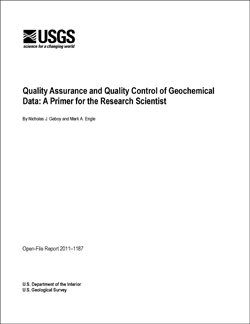Open-File Report 2011–1187

IntroductionGeochemistry is a constantly expanding science. More and more, scientists are employing geochemical tools to help answer questions about the Earth and earth system processes. Scientists may assume that the responsibility of examining and assessing the quality of the geochemical data they generate is not theirs but rather that of the analytical laboratories to which their samples have been submitted. This assumption may be partially based on knowledge about internal and external quality assurance and quality control (QA/QC) programs in which analytical laboratories typically participate. Or there may be a perceived lack of time or resources to adequately examine data quality. Regardless of the reason, the lack of QA/QC protocols can lead to the generation and publication of erroneous data. Because the interpretations drawn from the data are primary products to U.S. Geological Survey (USGS) stakeholders, the consequences of publishing erroneous results can be significant. The principal investigator of a scientific study ultimately is responsible for the quality and interpretation of the project's findings, and thus must also play a role in the understanding, implementation, and presentation of QA/QC information about the data. Although occasionally ignored, QA/QC protocols apply not only to procedures in the laboratory but also in the initial planning of a research study and throughout the life of the project. Many of the tenets of developing a sound QA/QC program or protocols also parallel the core concepts of developing a good study: What is the main objective of the study? Will the methods selected provide data of enough resolution to answer the hypothesis? How should samples be collected? Are there known or unknown artifacts or contamination sources in the sampling and analysis methods? Assessing data quality requires communication between the scientists responsible for designing the study and those collecting samples, analyzing samples, treating data, and interpreting results. This primer has been developed to provide basic information and guidance about developing QA/QC protocols for geochemical studies. It is not intended to be a comprehensive guide but rather an introduction to key concepts tied to a list of relevant references for further reading. The guidelines are presented in stepwise order beginning with presampling considerations and continuing through final data interpretation. The goal of this primer is to outline basic QA/QC practices that scientists can use before, during, and after chemical analysis to ensure the validity of the data they collect with the goal of providing defendable results and conclusions. |
Posted September 7, 2011 For additional information contact: Part or all of thi999s report is presented in Portable Document Format (PDF); the latest version of Adobe Reader or similar software is required to view it. Download the latest version of Adobe Reader, free of charge. |
Geboy, N.J., and Engle, M.A., 2011, Quality assurance and quality control of geochemical data—A primer for the research scientist: U.S. Geological Survey Open-File Report 2011–1187, 28 p., available at https://pubs.usgs.gov/of/2011/1187.
Introduction
Considerations Prior to Sample Collection
Considerations During Sample Collection
Tips for Sample Submittal
Post Laboratory Analysis
Closing Remarks
References